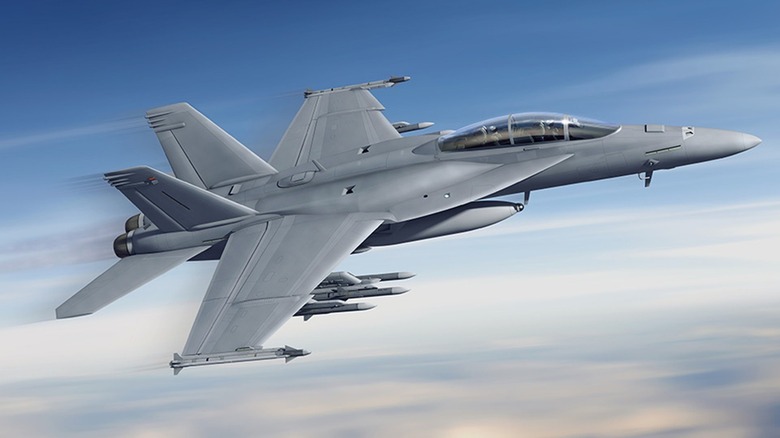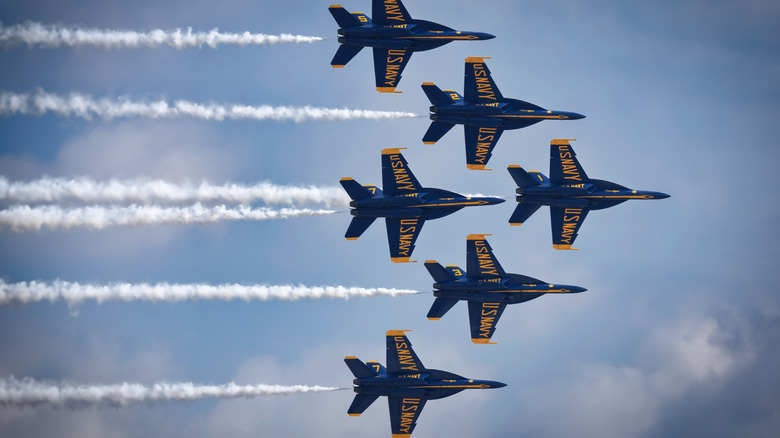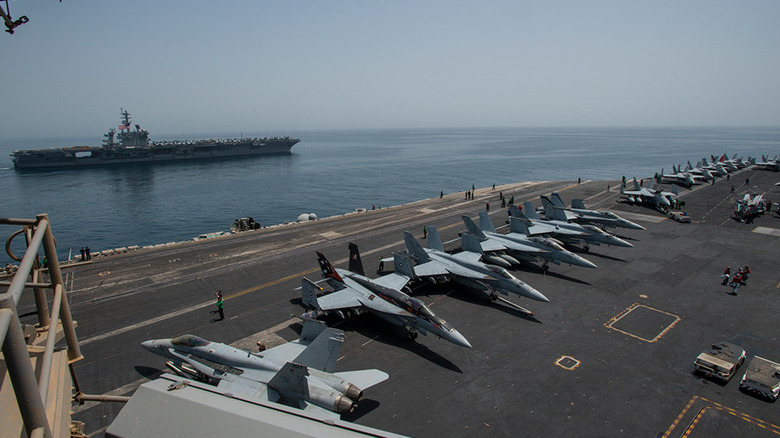What Is The Top Speed Of The US Navy's F/A-18 Super Hornet?
The U.S. Marines and U.S. Navy first deployed the F/A-18 Hornet aircraft in 1985 to be a versatile strike fighter on the front lines. The Hornet would serve in the U.S. Navy until 2019. The Super Hornet entered the fleet in 1999, the second major update to the original Hornet. The Super Hornet can reach speeds up to 1,190 miles per hour (MACH 1.6), which is considered pretty average for a modern fighter jet. However, Russia's MiG-31 Foxhound can go up to 1,864 mph (MACH 2.83), and China's J-15 Flying Shark reaches 1,400 mph (MACH 1.8). Even the U.S.'s jet that came before the Hornet, the F-14 Tomcat, was faster — it could hit 1,544 mph (MACH 2).
If the Hornet isn't known for its speed, what has made it such a mainstay over the years? Often used for dogfights (slang for close-range fighter jet combat), the Hornet was more focused on its maneuvering than being the fastest jet in the skies. Former U.S. Marine Corps Pilot Louis Gundlach told the National Security Journal that the Super Hornet's " instantaneous turn" was better than most jets he flew against.
The Blue Angels adopt the Super Hornet for airshows
Despite being slower than other non-stealth jets throughout its career in the U.S. Marines and U.S. Navy, the Hornet has a very colorful history in combat. Developed by American defense contractor McDonnell Douglas and Northrop as a strike fighter, the Hornet was first deployed to the USS Constellation warship in 1985 — and its agility did not go unnoticed.
A year later, the Navy Flight Demonstration Squadron (better known as the Blue Angels) replaced the A-4 Skyhawk with the F/A-18, and became the longest-serving aircraft with the Blue Angels. The Boeing Super Hornet took over in 2021. "The F/A-18C hit a sweet spot combining versatility and affordable maintainability," said National Air and Space Museum Curator Michael W. Hankins. "The Hornet is a very agile, maneuverable airplane, which makes it effective in combat situations. Those same qualities make it great for airshows, too. And because of its advanced electronics and radar systems, it can perform both fighter and attack roles."
The Super Hornets used by the Blue Angels were often retired from combat. While the Blue Angels flew a modified version without weapons, the Super Hornets that saw battle could be deadly.
The F/A-18's long history in combat
The first time the original Hornet saw combat was Operation El Dorado Canyon, an air strike over Libya that was shrouded in controversy but proved the U.S. Air Force's ability to precisely strike targets thousands of miles away. With the Hornet proving its agility and high alpha flight capabilities, it got upgrades over the years. In 1987, a Hornet with the ability to carry a medium-range air-to-air missile was deployed, followed by a night version in 1990. This led to the Hornet's use in Operation Desert Storm in 1991, defeating two Iraqi MiG-21s and an A-6 Intruder. Not only that, but the Hornet proved it could take a hit from a missile and still fly the next day, showcasing fast recovery and survivability needed for intense missions.
The Hornet was used in more flights throughout its service, including Operation Southern Watch in 1992, Operation Enduring Freedom in 2001, and Operation Iraqi Freedom in 2003, which also included the new Super Hornet, both conducting strike missions. The current Super Hornet is designed for every type of mission, from air superiority to weapon strikes to close air support to reconnaissance. The Super Hornet has also assisted with escorting, like in 2012 when two Super Hornets escorted a NASA Boeing 747 Shuttle Carrier Aircraft over the Space Shuttle Endeavour in California. Very recently, the Navy used Super Hornets to perform ground attacks against the Houthi rebels in Yemen.


